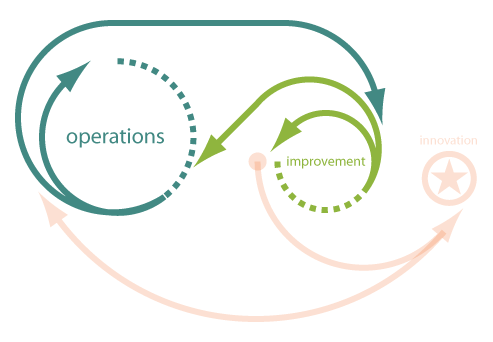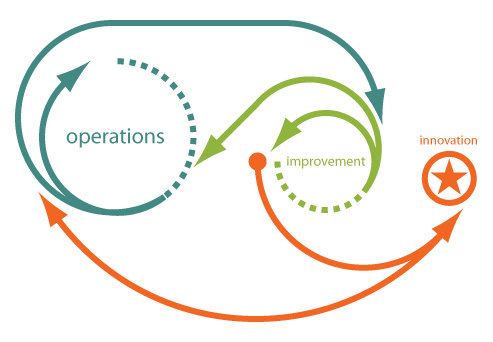The Operations Cycle

In many businesses, the sole focus is on the Operations Cycle. This is to be expected as Operations is where the activities of the business translate (hopefully) into profits. The Operations Cycle is where “work” happens.
During the Operations Cycle, the aim is to maximise repeatability and minimise variation. This should be a well-oiled machine at work. There should be a process to painlessly handle all situations that could arise.
Unfortunately, not many businesses these days can afford to focus solely on doing the work. This head-in-the-sand behaviour allows competitors to overtake a business.
The Improvement Cycle

The Quality Movement introduced the concepts of continual learning and improvement. Enter the Improvement Cycle.
Every so often, a business will look up from its Operations Cycle and do a bit of learning and improvement. During the Improvement Cycle, the business reviews what it has been doing, collate suggestions, identify problems, and come up with improvements. This is also the time to design and test brand new processes to cope with newly identified situations and requirements.
Once improvements are tested, they are injected back into the Operations Cycle. Small improvements (that has little chance of severely interrupting operations should they go wrong) may well be tested in the Operations Cycle.
The Innovation Interrupt

I am calling this an interrupt and not a cycle. Because it is an interrupt to the business. Where the Operations and Improvement Cycles are focused on polishing the silver that is the business’ processes, innovation is about buying new silver, or even building a whole new kitchen.
The Innovation Interrupt is where all bets are off. Everything can be questioned, challenged, and re-imagined. It is here that businesses create breakthrough services and products, branch out to enter new niche markets, and even fundamentally re-invent themselves.
In the diagram, I have drawn the Innovation Interrupt is the smallest item. The reason is quite pragmatic. Even if a business is innovating all the time (perhaps because they have a full time innovation group) the reality is that Operations and Improvement will still consume the majority of a business’ time and resources.
Innovation is only useful to the extent that it provides the ideas to fuel the Operations and Improvement cycles. Because it is in these cycles where innovative ideas become real, ready to be transforms into profit to sustain and further the business.